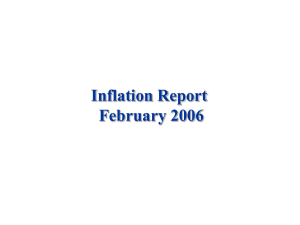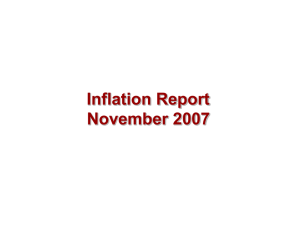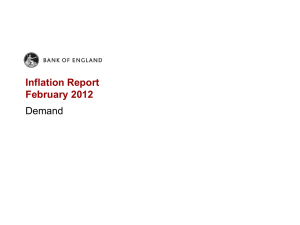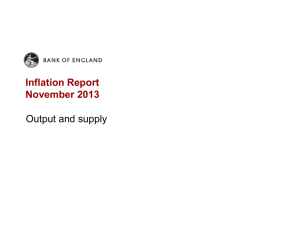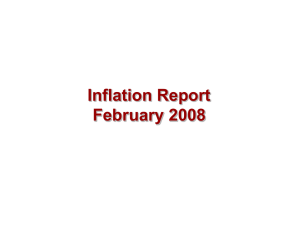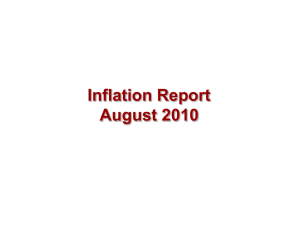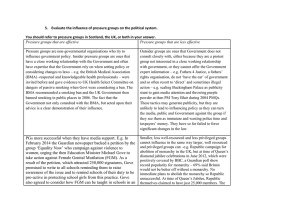Inflation Report May 2006
advertisement
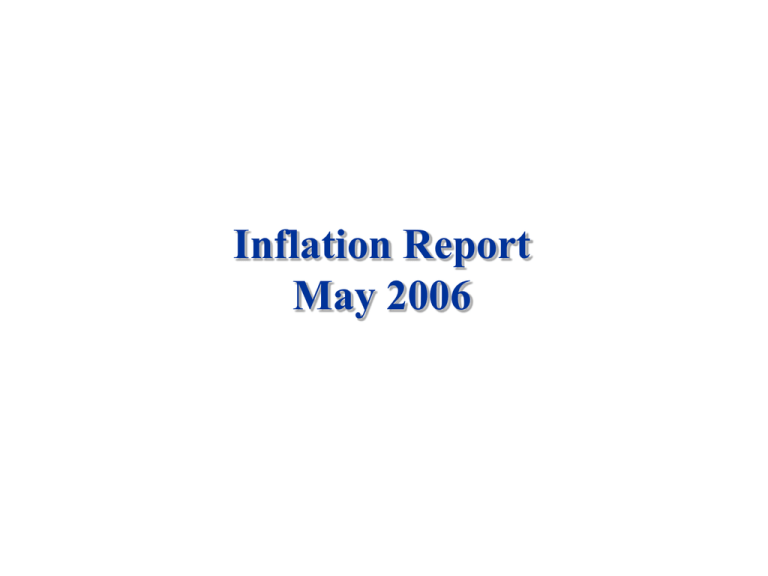
Inflation Report May 2006 Output and supply Chart 3.1 Whole-economy output(a) (a) Chained-volume measure of gross value added at basic prices. 2006 Q1 data were unavailable at the time of the February Report. Chart 3.2 Contributions to quarterly output(a) growth (a) Chained-volume measure of gross value added at basic prices. Chart 3.3 Manufacturing output and exports of goods(a) (a) Bank estimates based on ONS data. Goods exports exclude both fuels and an estimate of the effects of fraud. Chart 3.4 Manufacturing output and final domestic demand Chart 3.5 Employment(a) (a) Employment of those aged 16+ from the LFS are for non-overlapping quarters ending in February, May, August and November each year. Chart 3.6 Agents’ survey: employment(a) (a) Based on 224 responses from a survey of private sector companies by the Bank of England’s regional Agents in February 2006, weighted by respondents’ number of employees. Companies were asked what had happened to the number of their employees over the past six months, and what they expected to happen to employee numbers over the next six months. (b) Excludes the public sector. Chart 3.7 Output per worker(a) (a) The estimates for 2006 Q1 are constructed using the preliminary estimate of GDP, and the assumption that LFS employment in 2006 Q1 grows by the same quarterly rate as in the three months to February. Chart 3.8 Private sector capital services(a) (a) See Oulton, N and Srinivasan, S (2003), ‘Capital stocks, capital services, and depreciation: an integrated framework’, Bank of England Working paper no. 192, for a discussion of how these data are constructed. Chart 3.9 Energy intensity and manufacturing output(a) (a) (b) (c) (d) Based on a division of manufacturing into 74 sectors. Data for some small manufacturing sub sectors are not available. Excludes petrol. Change in average four-quarter growth between 1996 Q4–2003 Q4 and 2003 Q4–2005 Q4. Fertilisers, which account for 0.1% of manufacturing output. Oil and gas inputs as a proportion of total output. Bank estimates based on ONS data. Chart 3.10 Survey measures of private sector factor utilisation(a) Sources: Bank of England, BCC, CBI/Grant Thornton and CBI/PwC. (a) Bank calculations based on the BCC survey balances for the manufacturing and service sectors, the CBI survey for the manufacturing sector, CBI/Grant Thornton surveys of the consumer and business services sectors, the CBI/PwC survey of the financial services sector and the Bank’s regional Agents’ scores for capacity pressure in the manufacturing and service sectors. The series have been subtracted by their respective means and divided by their standard deviations to normalise for volatility. Chart 3.11 Illustrative measures of private sector factor utilisation based on production functions(a) (a) Data are to 2005 Q4. The capital input series is the private sector measure described in Chart 3.8. The labour input series is private sector hours worked. (b) The higher the elasticity of substitution, the easier it is for companies to switch capital for labour and vice versa. For more details on these production functions, see Ellis, C and Price, S (2003), ‘The impact of price competitiveness on UK producer price behaviour’, Bank of England Working Paper no. 178. Chart 3.12 Unemployment rate (a) Three-month moving average. This measure includes all those actively looking for work and available to start, and those due to start a new job in the next two weeks. Chart 3.13 Job vacancies per unemployed person(a) (a) Number of job vacancies divided by the LFS measure of unemployment. Both series are three-month averages. Vacancies exclude agriculture, forestry and fishing. Chart 3.14 Vacancies(a) (a) Vacancies data as defined in Chart 3.13. The areas of the circles on the chart are proportional to the level of employment in the respective sectors in 2005 Q4 as a share of total employment. (b) Includes hotels and catering. Tables Table 3.A Surveys of service sector activity 2005 2006 Average(a) Q1 Q2 Q3 Q4 Q1 Apr. 56.0 56.0 55.8 55.5 56.6 57.7 59.7 18 11 10 14 26 n.a. 18 39 14 18 41 44 n.a. 3 33 0 9 0 -10 n.a. CIPS/RBS business activity index(b) BCC sales balance(c) 18 CBI/Grant Thornton (business) CBI/Grant Thornton (consumer) Sources: BCC, CBI /Grant Thornton and CIPS/RBS. (a) Average taken from 1996 for the CIPS survey, 1991 for the BCC survey, and 1998 for the CBI/Grant Thornton survey. (b) Quarterly data refer to the average of the three CIPS/RBS monthly indices. An index above/below 50 implies rising/falling activity. (c) Average of the ‘home sales’ and ‘export sales’ balances. Table 3.B Output of the service industries Percentage changes on a quarter earlier Average 2005 1995–2004 Q1 2006 Q2 Q3 Q4 Q1 Distribution, hotels and catering 0.8 -0.2 0.3 0.1 1.1 0.0 Business services and finance 1.0 0.9 0.8 1.1 1.1 0.9 Transport and communications 1.3 1.2 0.4 0.6 1.4 0.9 Government and other services 0.6 0.8 0.8 0.9 0.5 0.5 Table 3.C Survey data on employment intentions Average 2005 2006 2000–06 Q1 Q2 Q3 Q4 Q1 5 18 0 8 10 8 -19 -15 -14 -15 -16 -15 20 24 13 19 20 24 5 12 11 14 -16 1 15 28 23 6 12 27 Manufacturing balances BCC(a)(b) CBI(b) Services balances BCC(b) CBI/Grant Thornton(c) (consumer) CBI/Grant Thornton(c) (business) Sources: BCC, CBI and CBI/Grant Thornton. (a) Also includes agriculture, energy and construction. (b) Seasonally adjusted by Bank staff. (c) Not seasonally adjusted. Table 3.D Survey evidence on recruitment difficulties and labour shortages 2005 2006 Average(a) Q1 Q2 Q3 Q4 Q1 Apr. 48.3 42.8 46.0 48.0 45.6 45.6 46.4 49.1 46.4 49.1 50.6 48.8 51.5 50.2 BCC: manufacturing(e) 64 58 44 44 46 39 n.a. BCC: services 60 64 63 58 61 62 n.a. Availability of agency staff(b) KPMG/REC: Permanent KPMG/REC: Temporary Recruitment difficulties(c)(d) Factors likely to limit output(c)(f)(g) CBI: skilled labour 12 11 11 16 10 15 n.a. CBI: other labour 3 3 3 4 2 2 n.a. Sources: BCC, CBI and KPMG/REC. (a) (b) (c) (d) (e) (f) (g) Averages are from 1995 apart from the KPMG/REC survey (October 1997). Indices, for which 50 represents no change. Data are not seasonally adjusted. Percentage balance of firms. Also includes agriculture. Manufacturing sector. Percentages (weighted by respondents).
